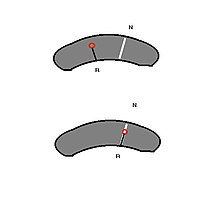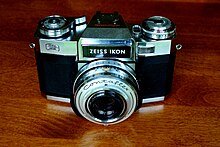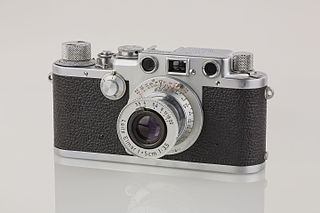
A camera is an instrument used to capture and store images and videos, either digitally via an electronic image sensor, or chemically via a light-sensitive material such as photographic film. As a pivotal technology in the fields of photography and videography, cameras have played a significant role in the progression of visual arts, media, entertainment, surveillance, and scientific research. The invention of the camera dates back to the 19th century and has since evolved with advancements in technology, leading to a vast array of types and models in the 21st century.

In photography, exposure value (EV) is a number that represents a combination of a camera's shutter speed and f-number, such that all combinations that yield the same exposure have the same EV. Exposure value is also used to indicate an interval on the photographic exposure scale, with a difference of 1 EV corresponding to a standard power-of-2 exposure step, commonly referred to as a stop.

Zorki is the name of a series of 35mm rangefinder cameras manufactured in the Soviet Union between 1948 and 1978.
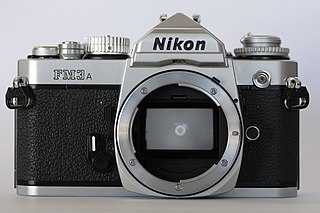
The Nikon FM3ᴀ is an interchangeable-lens, focal-plane shutter, 35 mm film, single-lens reflex (SLR) camera. It was manufactured by Nikon Corporation in Japan, on small-volume assembly lines, from 2001 to 2006. The camera was available in two colours: all black and satin chrome. The introductory US list price for the chrome body only was $820.
Kiev is a Soviet and Ukrainian brand of photographic equipment including cameras manufactured by the Arsenal Factory in Kyiv, Ukraine. The camera nameplates show the name "KIEV", with older cameras using "КИЕВ" or "КИЇВ" in Cyrillic.

The Nikon FE2 is a 35 mm single lens reflex (SLR) camera manufactured by Nippon Kogaku K. K. in Japan from 1983 to 1987. The FE2 uses a Nikon-designed vertical-travel focal-plane shutter with a speed range of 8 to 1/4000th second, plus Bulb and flash X-sync of 1/250th second. It was available in two colors: black with chrome trim and all black. The introductory US list price for the chrome body only was $446. Note that SLRs usually sold for 30 to 40 percent below list price.

The Nikon FE is an advanced semi-professional level, interchangeable lens, 35 mm film, single-lens reflex (SLR) camera. It was manufactured by Nikon in Japan from 1978 to 1983, and was available new from dealer stock until c. 1984. The FE uses a metal-bladed, vertical-travel focal plane shutter with a speed range of 8 to 1/1000 second, plus Bulb, and flash X-sync of 1/125th second. It had dimensions of 89.5 millimetres (3.52 in) height, 142 mm (5.6 in) width, 57.5 mm (2.26 in) depth and 590 grams (21 oz) weight. It was available in two colors: black with chrome trim and all black. As on the FM, its model designation did not appear on the front of the camera, but was engraved as a small "FE" preceding the serial number on the rear of the housing.

The Canon EF is a manual focus 35mm single-lens reflex camera produced by Canon between 1973 and 1978. It was compatible with Canon's FD-mount lenses. The EF was built as an electro-mechanical version of Canon's top-of-the line wholly mechanical Canon F-1. The shutter is mechanical at all speeds ½ second and faster, but at 1 second and longer the shutter is all electronically controlled, allowing AE exposures from 1/1000 to 30 seconds. The EF shares the F-1's rugged construction and tough metal body. Unlike the F-1, the EF does not support any motor drive for film transport. Neither does it provide any interchangeable viewfinder.
The Olympus OM System was a line of 35mm single-lens reflex cameras, lenses and accessories sold by Olympus between 1972 and 2002. The system was introduced by Olympus in 1972. The range was designed by Yoshihisa Maitani, chief designer for Olympus, and his staff; OM stands for Olympus Maitani.

The Olympus OM-2 is a professional single-lens reflex film system camera produced by Olympus of Japan from 1975 to 1988.

Nikkormat was a brand of cameras produced by the Japanese optics company Nippon Kogaku K. K., as a consumer version of the professional Nikon brand. Nikkormat cameras, produced from 1965 until 1978, were simpler and more affordable than Nikon-branded cameras, but accepted the same lenses as the Nikon F series cameras.
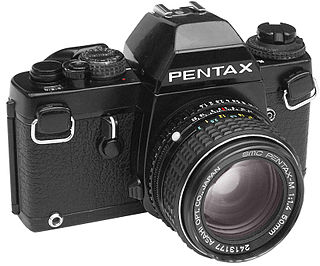
The Pentax LX is a 35mm single-lens reflex camera produced by Pentax in Japan. It was introduced in 1980 to commemorate the 60th anniversary of Asahi Optical Co., and was produced until 2001. It is the top-of-the-line professional, or "system", camera in the Pentax manual focus range, with manual and aperture priority automatic exposure modes and an advanced light metering system. The LX uses the K mount, which is the Pentax proprietary bayonet lens mount, and has a large body of accessories. The camera has several unique or uncommon features, and compared with contemporary professional camera bodies from rival manufacturers, like the Canon New F-1 or Nikon F3, the LX body is smaller and lighter, weighing in at 570 grams with its standard FA-1 finder.

Minolta 16 refers to a line of 16mm subminiature cameras made by Minolta between 1955 and 1974. The negative size was 10x14 mm for the earlier models, later, a larger format, 12x17 mm was adopted, using single-perforated 16 mm film. It was possible to load your own cassettes, and also develop the film using a special developing tank with a spiral insert for 16 mm film.

A mode dial or camera dial is a dial used on digital cameras to change the camera's mode. Most digital cameras, including dSLR and SLR-like cameras, support modes, selectable either by a rotary dial or from a menu. On point-and-shoot cameras which support modes a range of scene types is offered. On dSLR cameras and SLR-like cameras, mode dials usually offer access to manual settings. The more compact point-and-shoot cameras, and cameras offering a great many modes, do not have mode dials, using menus instead. Some SLR lenses themselves offer control over things such as aperture, reducing the need for mode support in the camera body.
The Konica F was the first 35 mm SLR camera produced by Konishiroku, released in February 1960.

The Contaflex series is a family of 35mm Single-lens reflex cameras (SLR) equipped with a leaf shutter, produced by Zeiss Ikon in the 1950s and 1960s. The name was first used by Zeiss Ikon in 1935 for a 35mm Twin-lens reflex camera, the Contaflex TLR; for the earlier TLR, the -flex suffix referred to the integral reflex mirror for the viewfinder. The first SLR models, the Contaflex I and II have fixed lenses, while the later models have interchangeable lenses; eventually the Contaflexes became a camera system with a wide variety of accessories.

The Kodak Retina Reflex is a discontinued series of four single-lens reflex cameras made by Kodak in Germany between 1957 and 1974, as part of the Kodak Retina line of 35mm film cameras.

The Bessamatic and Ultramatic were lines of 35mm SLR cameras made by Voigtländer in the 1960s, featuring a selenium meter. It uses a leaf shutter, similar to competing SLR cameras manufactured by Kodak and Zeiss Ikon in Germany, rather than the focal plane shutter almost universally adopted by Japanese SLRs such as the contemporary Nikon F and Pentax Spotmatic. The Ultramatic was released in 1963, which used the same lens mount and added a shutter-priority autoexposure mode.

Contarex is a line of 35mm single lens reflex cameras (SLRs) made by Zeiss Ikon. It was first presented at Photokina in 1958 and initially scheduled for delivery in the spring of 1959, but it was not made generally available in the United States until March 1960. The first model is popularly known as the Contarex I, the Bullseye, or the Cyclops, after the prominent light meter window above the lens, in front of the pentaprism. The camera was aimed at the high-end and professional markets; in 1961, the retail price was $499.
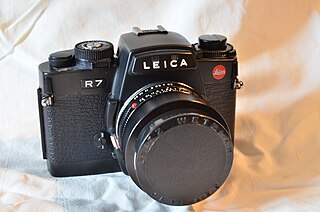
Leica R4, R5, R6, R7 were 35 mm SLR cameras manufactured by Leica between 1980 and 1997 and belonged to the manual focusing R-System, which was offered from 1965 to 2009.

